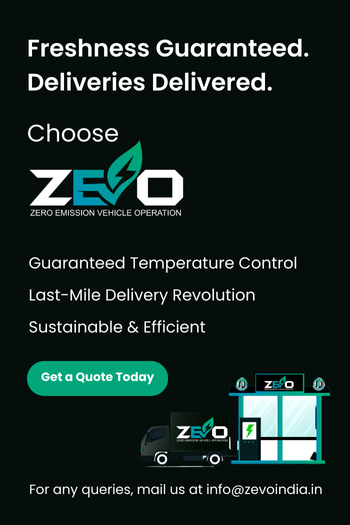How to Set Up a Food Delivery Fleet with Electric Vehicles

Akshay Sharma
CEO's Office @ZEVO
As the demand for sustainable food delivery grows, many restaurants and delivery services are considering the transition to an electric vehicle fleet for food delivery. Not only can this move reduce carbon footprints, but it can also lead to significant cost savings in the long run. Here’s a comprehensive guide to help you set up your EV fleet for restaurants, featuring insights from ZEVO and their innovative EV-as-a-Service for food delivery model.
Step 1: Vehicle Selection
Assess Your Delivery Needs
Start by evaluating your delivery requirements. Consider factors such as delivery volume, electric vehicle capacity, and range. Popular electric options include:
- Electric Cargo Bikes: Ideal for urban deliveries.
- Small Electric Vans: Such as the Nissan e-NV200, perfect for short to medium-range deliveries.
- Larger Electric Vans: Like the Mercedes eSprinter for longer routes.
Evaluate Total Cost of Ownership
When selecting vehicles, look beyond the purchase price. Calculate the total cost of ownership, which includes electric vehicle maintenance, fuel savings, and potential resale value. While EVs may have a higher upfront cost, they typically offer lower operating costs, providing significant cost savings from using electric vehicles for delivery over time.
Explore Government Incentives
Research local and federal incentives that can help offset the initial costs of purchasing or leasing EVs. Many regions offer government incentives for electric vehicle fleets, such as tax credits, rebates, or grants specifically for electric vehicle adoption.
For tailored advice, consider consulting with ZEVO. Their expertise can guide you in selecting the right vehicles for your specific needs, ensuring that you make informed decisions that align with your operational goals. ZEVO electric vehicles are designed for efficiency, and their solutions can make a significant difference in setting up a sustainable and cost-effective fleet.
Step 2: Charging Infrastructure
Identify Charging Requirements
Assess your fleet’s daily mileage to determine the necessary electric vehicle charging infrastructure. This will help you understand how many charging stations you need and what types are best suited for your operation, ensuring efficient and sustainable food delivery.
Upgrade Electrical Capacity
Ensure your facility can support the charging load. This may involve upgrading your electrical service. Collaborate with local utilities to assess your current capacity and make necessary improvements to support your electric vehicle fleet setup.
Install Charging Stations
Set up Level 2 charging stations at your location. These stations provide a good balance between charging speed and cost. ZEVO can assist you in establishing a convenient and efficient charging infrastructure for food delivery businesses.
Utilize EV-as-a-Service
Consider ZEVO’s EV-as-a-Service model, which offers integrated charging solutions and fleet management. This approach simplifies the process of managing your charging network and ensures that your vehicles are always ready for delivery.
Implement Smart Charging Solutions
Use software to manage charging schedules and optimize electricity costs. Smart charging can help you avoid peak electricity rates and reduce overall energy expenses.
Step 3: Operations and Maintenance
Train Your Staff
Provide comprehensive training for your drivers on EV operation, charging protocols, and maintenance practices. This will ensure that your team is well-equipped to handle the unique aspects of electric vehicle maintenance.
Develop a Charging Schedule
Create a routine that ensures all vehicles are charged and ready for use. A well-planned charging schedule minimizes downtime and maximizes delivery efficiency.
Monitor Fleet Performance
Leverage data analytics provided by ZEVO to track vehicle performance and optimize delivery routes. This data-driven approach can enhance operational efficiency and reduce costs, especially when considering electric vehicle cost comparisons.
Consider Flexible Subscription Plans
With ZEVO’s EV-as-a-Service, you can access flexible subscription plans that allow for vehicle upgrades and adjustments as your business needs evolve. This flexibility can be a game-changer for adapting to changing market demands.
Budget for Maintenance
While EVs generally require less maintenance than traditional vehicles, it’s important to budget for regular checks and servicing to ensure optimal performance.
Conclusion
Transitioning to an electric vehicle fleet for food delivery is a significant step towards sustainability and operational efficiency for food delivery services. By leveraging ZEVO’s expertise and the EV-as-a-Service model, you can streamline the transition, reduce costs, and enhance your brand’s commitment to environmental responsibility. For personalized consultation and support in setting up your electric vehicle fleet, reach out to ZEVO today. Embrace the future of delivery with electric vehicles and make a positive impact on your business and the planet!

Share this Article
Subscribe to our newsletter
Be the first to receive exclusive offers and the latest news on our products and services directly in your inbox.
